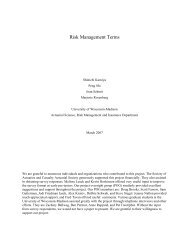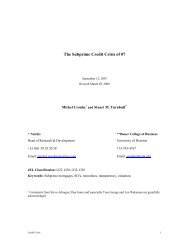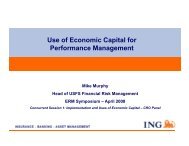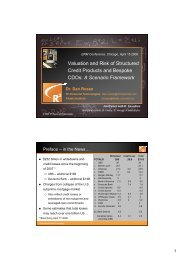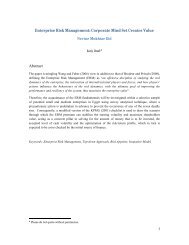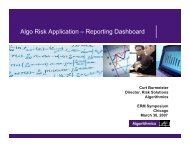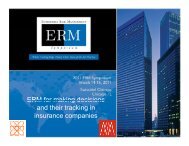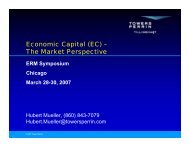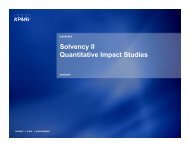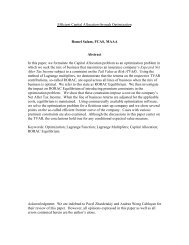Bayesian Risk Aggregation: Correlation ... - ERM Symposium
Bayesian Risk Aggregation: Correlation ... - ERM Symposium
Bayesian Risk Aggregation: Correlation ... - ERM Symposium
Create successful ePaper yourself
Turn your PDF publications into a flip-book with our unique Google optimized e-Paper software.
(4) Take x (k+1) =<br />
<br />
y, with probability δ,<br />
x (k) , else.<br />
(5) If k = IMH − 1 then stop and set zi = x (k+1) , else set k = k + 1 and go to (2).<br />
(III) Set (r (t+1)<br />
1<br />
, . . . , r (t+1)<br />
6 ) = (z1, . . . , z6).<br />
If t = IGibbs − 1 then stop, else set t = t + 1 and go to (II).<br />
4 A simulation study of aggregated EC<br />
We now illustrate our new approach by means of a fictitious numerical example. We<br />
assume that the empirical correlation matrix B of the Gaussian copula as defined in (2.4)<br />
is given by<br />
⎛<br />
⎜ MR<br />
⎜<br />
B = ⎜ CR<br />
⎜<br />
⎝ OR<br />
MR<br />
1<br />
0.66<br />
0.30<br />
CR<br />
0.66<br />
1<br />
0.30<br />
OR<br />
0.30<br />
0.30<br />
1<br />
⎞<br />
BR<br />
⎟<br />
0.58 ⎟<br />
0.67 ⎟ ,<br />
⎟<br />
0.60 ⎠<br />
(4.1)<br />
BR 0.58 0.67 0.60 1<br />
which are actually the benchmark inter-risk correlations reported in the IFRI/CRO survey<br />
[15], Figure 10. This matrix was also used in the simulation study in Böcker [5]. Since this<br />
matrix is not derived from actual risk proxy data, we have to assume a fictitious value for<br />
the time series length n in the likelihood function (2.3). We chose it to be n = 10, think<br />
e.g. of 2.5 years of quarterly data.<br />
In addition to the empirical information above we assume subjective prior knowledge<br />
in order to completely specify the posterior distribution (3.8). Let us suppose that expert<br />
elicitation as explained in Section 5 has been performed to estimate the mean values µi<br />
and standard deviations σi of all pair correlations ri, i = 1, . . . , 6, which by relationships<br />
(3.5) and (3.7) can be used to compute the hyperparameters αi and βi. The assumed<br />
outcome of the expert judgement is shown in Table 4.3 for all six pair correlations. In<br />
addition, Figures 4 and 5 in the Appendix depict also the prior densities parameterised<br />
according to Table 4.3 together with the empirical estimates (4.1).<br />
For the simulation of the posterior distribution of the inter-risk-correlation matrix we<br />
ran the algorithms described in Examples 3.4 and 3.5 for the beta and the triangular<br />
model, respectively. The starting value R (0) is chosen as the empirical matrix (4.1). Fur-<br />
thermore, for the triangular (beta) model we set IMH = 1, 000 (1, 000) for each Metropolis-<br />
Hastings step within the Gibbs algorithm and IGibbs = 100, 000 (300, 000). In the trian-<br />
gular model we used only the last 9,000 iterations of the chain for posterior analysis and<br />
13



